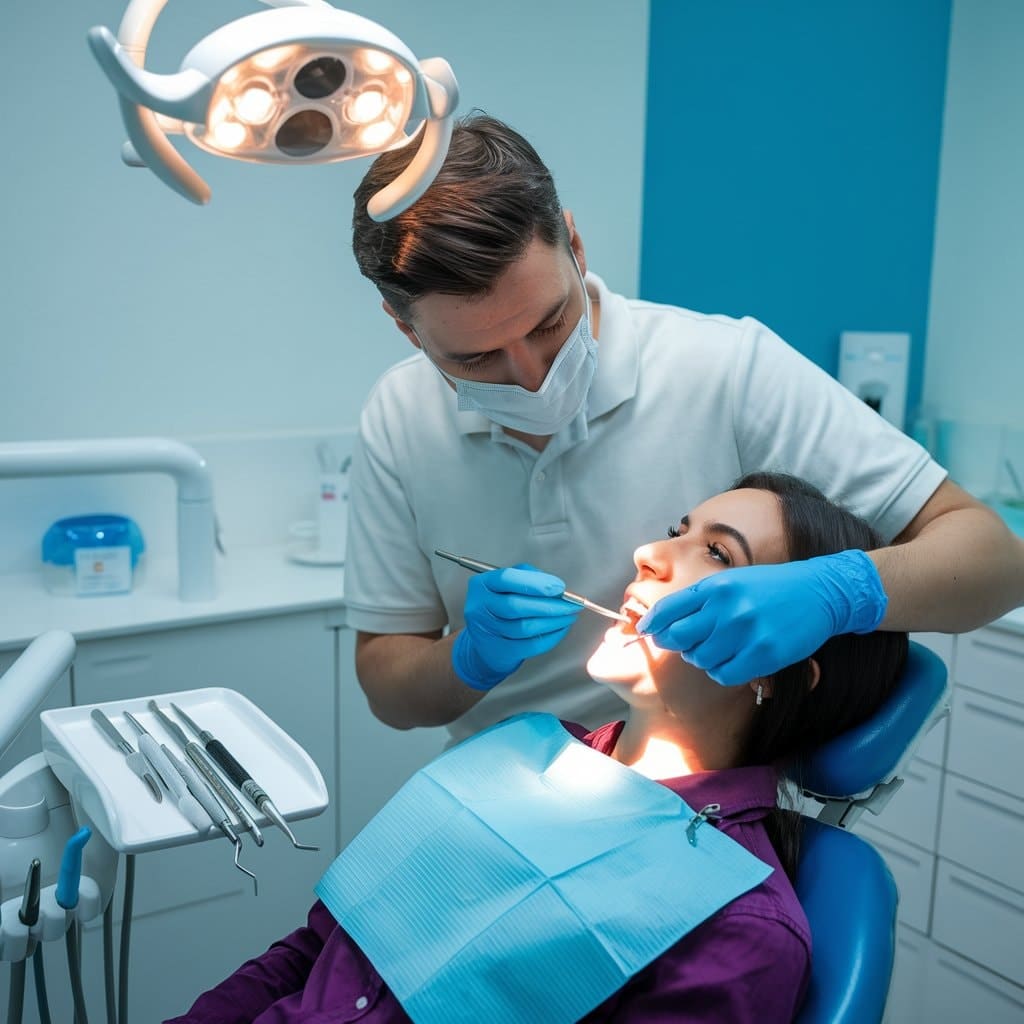Many people worry about keeping their teeth white and shiny, but they often forget about their gums. Yet, gum health is key to a bright smile and avoiding pain in your mouth. Gum disease can sneak up on you if you’re not careful, leading to problems like bleeding gums, tooth loss, and even affecting your overall health.
Here’s an interesting fact: scientists have found links between gum disease and heart disease. Knowing how to protect gum disease is crucial for not just your mouth’s wellness but also for your whole body’s health.
This article will give you easy steps to maintain healthy gums and prevent gum disease from starting. Ready? Let’s keep those smiles bright!
What is Gum Disease, and How Does it Develop?
Gum disease, also known as periodontal disease, begins when plaque builds up along the gum line. This sticky film contains bacteria that can harm your gums and teeth. If you don’t remove plaque through brushing and flossing, it turns into tartar.
Unlike plaque, tartar is tough and can only be removed by a dentist or dental hygienist during a professional cleaning. The longer tartar stays on your teeth, the more damage it can cause.
The early stage of gum disease is gingivitis. Gums may become red, swollen, and bleed easily at this stage. Thankfully, gingivitis is reversible with good oral hygiene and regular dental visits.
However, if left untreated, it can progress to periodontitis. This advanced stage of gum disease affects not just the gums but also the bone that supports your teeth, which could lead to tooth loss.
Next, we’ll look at understanding the different stages of gum disease in more detail.
Understanding the Different Stages of Gum Disease
Gum disease develops in stages, starting from mild conditions that can worsen if not treated early. The first stage is gingivitis, where gums become red and swollen and may bleed easily during brushing or flossing.
This results from plaque buildup around the teeth, which harbours harmful bacteria. Gingivitis is reversible with proper oral hygiene routines including regular brushing and flossing along with professional cleanings.
As gum disease progresses without treatment, it advances to periodontitis. At this stage, the inner layer of the gum and bone starts to pull away from the teeth to form pockets that collect debris and can become infected.
These infections cause a breakdown of the bone and connective tissue that hold teeth in place. Without intervention, this leads to loose teeth or eventual tooth loss due to destroyed supporting structures.
Early detection and treatment of gum disease can prevent irreversible damage.
Common Symptoms of Gum Disease to Watch Out For
Gums that bleed easily during brushing or flossing often hint at gum disease. Such a problem might appear minor, but it’s a distinct sign that plaque and bacteria have started to irritate your gums.
Persistent bad breath is another typical symptom not to dismiss. It’s typically a result of the same detrimental bacteria present in the plaque accumulating on your teeth and gums.
Inflamed, red gums indicate inflammation, which is a direct response to infection from oral bacteria associated with gum disease. Experiencing discomfort when chewing may also suggest this condition, particularly as gum disease advances and impacts the stability of teeth.
In extreme cases, individuals might spot their teeth becoming loose or changing position – both symptoms that the foundational structures of the teeth are being compromised by ongoing infections or potentially causing tooth loss if left untreated.
How Plaque and Tartar Contribute to Gum Disease
Plaque is a sticky film of bacteria that continuously forms on our teeth. If not removed by regular brushing and flossing, it can harden into tartar. Tartar is much tougher than plaque and can only be removed by professional cleaning at the dentist’s office.
Together, plaque and tartar build-up along the gum line, creating a perfect environment for bacteria to thrive. This leads to inflamed gums, which is the early stage of gum disease known as gingivitis.
If left untreated, gingivitis can progress to periodontitis, a more severe form of gum disease. This advanced stage involves not just the gums but also the bone that supports your teeth.
Periodontitis can lead to tooth loss and other serious health issues if ignored. Therefore, preventing plaque and tartar accumulation plays a vital role in maintaining healthy gums and preventing gum disease.
Understanding how to prevent this harmful buildup will guide us through effective prevention methods against gum disease.
How Can I Prevent Gum Disease?
Preventing gum disease starts with good oral care routines. Brushing your teeth twice a day and flossing daily remove plaque bacteria, which can lead to gum disease if not managed properly.
Regular dental cleanings also play a critical role in keeping gums healthy by removing tartar buildup that at-home brushing can miss. Using toothpaste that contains fluoride helps protect your teeth and reduces the risk of gum disease.
Eating a balanced diet supports oral health by strengthening the immune system and reducing inflammation, which is vital in fighting off infections that can harm gums. Quitting smoking is another essential step since smoking weakens the body’s immune response, making it harder to fight off gum infection.
Together, these practices help maintain mouth healthy and lower the chance of developing early-stage gum disease or advanced periodontitis.

Importance of Regular Brushing and Flossing
Regular brushing and flossing are critical steps in maintaining oral health. They prevent gum disease and tooth decay and ensure healthy gums.
- Brush your teeth at least twice a day. This removes plaque that can lead to gum disease and tooth decay.
- Use fluoride toothpaste. Fluoride strengthens the enamel, making your teeth more resistant to decay.
- Floss daily. Flossing gets rid of food particles and plaque that your toothbrush can’t reach.
- Replace your toothbrush every three to four months. Old brushes become worn out and less effective at cleaning your teeth.
- Brush for two minutes each time. Patiently brushing ensures you’ve thoroughly cleaned all areas of your mouth.
- Use a soft-bristled brush. Hard bristles can harm gums, possibly leading to gums bleeding or recession.
- Incorporate a mouthwash. It can help reduce plaque and remove remaining food particles after brushing and flossing.
- Avoid tobacco products. Smoking increases the risk of gum disease by affecting the attachment of bone and soft tissue in your mouth.
- Limit sugary foods and drinks. Sugar contributes to tooth decay by providing food for bacteria. That produces harmful acids.
Choosing the right fluoride toothpaste is next in ensuring you keep those smiles bright and healthy!
Choosing the Right Fluoride Toothpaste for Healthy Gums
Finding the perfect fluoride toothpaste is critical for keeping gums healthy. Fluoride plays a vital role in preventing gum disease by strengthening tooth enamel and fighting off plaque buildup.
It’s essential to choose toothpaste with enough fluoride to protect gums from the early stages of gum disease, like gingivitis, which can lead to more severe conditions if untreated.
Look for products that specifically target gum health and have scientific backing.
Various options cater to different needs, such as toothpaste designed for sensitive teeth or those aiming to whiten while still protecting against gum disease. Always read labels carefully to ensure you’re getting a formulation that supports not just strong teeth but also healthy gums.
Consistent use of the right fluoride toothpaste can significantly reduce your risk of developing serious gum issues and maintain a healthier smile over time.
The Role of a Balanced Diet in Oral Health
Choosing an appropriate fluoride toothpaste is an imperative action towards preserving healthy gums while also considering a well-rounded diet that can be equally influential in oral health.
A diet abundant in vitamins and minerals elevates gum health and aids in averting gum disease. Foods that are rich in vitamin C and calcium can fortify your gums and teeth. These nutrients contribute to minimizing the susceptibility of gum recession, bone loss, and other symptoms correlated with periodontal disease.
Ingesting foods that are beneficial for your holistic health also favours your oral health. Crunchy fruits and vegetables can assist in naturally purifying teeth by eradicating plaque accumulation while you chew.
Decreasing sugar consumption is paramount to lessen the possibility of cavity formation and for lowering the potential of gum disease occurrence. Drinking a substantial amount of water is also important; it washes away food particles that bacteria thrive on and may instigate oral health problems if not discarded at once.
What Are the Treatment Options for Gum Disease?
Treating gum disease focuses on clearing the infection and stopping further damage to your gums and jaw bones. Dentists often start with a deep cleaning method known as scaling and root planning.
This process removes tartar buildup from above and below the gum line. For early stages of gum disease, such as gingivitis, this non-surgical treatment can reverse the condition. People with advanced periodontal disease might need gum surgery.
Procedures like flap surgery or bone grafts help repair damaged tissues.
Maintaining oral health after treatment is crucial. Regular check-ups allow your dentist to monitor recovery and prevent recurrence. They also offer advice on daily care routines to keep gums healthy.
Regular dental visits are a key part of preventing gum disease from advancing.
Non-Surgical Treatments for Gingivitis
Gingivitis is the early stage of gum disease that can progress to more serious health conditions if not treated. Non-surgical treatments are effective in reversing gingivitis and improving gum health.
- Regular cleanings with your dentist help remove tartar build-up that brushing alone can’t get rid of. These cleanings prevent and treat gum disease by getting rid of the plaque that causes gingivitis.
- Daily oral hygiene practices, including brushing twice a day and flossing, are key to stopping the progression of gingivitis. They keep teeth clean and reduce the risk of gum disease.
- Using fluoride toothpaste strengthens tooth enamel and helps prevent decay, which can cause gum problems.
- Antiseptic mouthwashes kill bacteria that contribute to plaque formation and swollen gums, reducing the signs of gum disease.
- Quitting smoking significantly lowers your risk of developing gum disease since smoking is a major contributor to dental health issues.
- Eating a balanced diet provides your gums with the nutrients they need to stay healthy and fight off infection.
- Increase water intake to help wash away food particles and bacteria from the mouth, which can eventually lead to plaque build-up.
- Dental professionals may apply antibiotic gels or prescribe oral antibiotics to reduce bacteria-causing gum inflammation.
Each non-surgical treatment aims at maintaining healthy gums and preventing the escalation of gingivitis can progress into more severe forms of gum disease, such as periodontitis, ensuring patients keep their smiles healthy for years to come.
When Gum Surgery is Necessary
Gum surgery becomes a must for patients in the final stage of gum disease, also known as periodontal disease. This condition occurs when deep cleaning by a dentist is no longer enough to stop the damage caused by gum disease.
Surgery can help repair the gums, remove the build-up of plaque and tartar under the gums, and restore health to your mouth and gums. It’s vital for anyone who wants to maintain healthy teeth and avoid further complications.
Dentists may recommend this type of treatment if regular check-ups reveal that non-surgical methods failed to treat gingivitis or early gum disease effectively. If you’re experiencing persistent unpleasant taste, warning signs like swollen gums, or bleeding during brushing, it’s crucial to see a dentist immediately.
Waiting too long could increase the risk of requiring more complex procedures. Gum surgery aims to prevent tooth loss, improve gum health, and lower your chances of emergency dental situations in the future.
Always consider seeing your dentist regularly for advice on how best to care for your oral health post-surgery.

How to Maintain Oral Health After Treatment
Maintaining oral health after treatment is crucial for preventing gum disease from returning. Here are ways to keep your gums healthy and avoid future problems.
- Stick to a strict oral hygiene routine. Brush your teeth twice a day with fluoride toothpaste.
- Floss daily to remove plaque buildup between teeth, which a toothbrush can’t reach.
- Use an antiseptic mouthwash to help reduce bacteria that cause gum disease.
- Stop smoking, as it increases the risk of gum disease and slows down healing.
- Schedule regular check-ups with your dentist every six months or more often if advised.
- Eat a balanced diet rich in vitamins and minerals to support healthy gums.
- If you have dentures or bridges, clean them regularly to prevent gum damage.
- Avoid sugary and acidic foods and drinks that can increase plaque buildup.
- Drink plenty of water throughout the day to help clean your mouth and gums.
- Practice stress-reduction techniques since stress can make it more challenging for your body to fight off infections, including gum disease.
Following these steps diligently will help protect your gums from future diseases and support overall oral health.
When Should I See a Dentist for Gum Issues?
Schedule an emergency appointment with a dentist or periodontist if early signs of gum disease appear. These include red, swollen gums, bleeding during brushing or flossing, constant bad breath, and loose feeling teeth.
Such symptoms suggest that your gums might be in danger due to gum disease.
“Regular check-ups are essential for gum disease prevention.” Regular dentist visits help identify potential issues before they escalate. Dentists are vital in managing periodontal disease, presenting treatment choices suitable for your requirements.
Don’t wait for pain; action at the initial sign of an issue helps safeguard your healthy smile.
Signs That Indicate You Need a Dental Check-Up
Bleeding gums during brushing or flossing can be a red flag for gum disease. This symptom should prompt you to seek a dental check-up immediately. Gum Disease symptoms like these signal that plaque build-up may be attacking your gums, putting you at higher risk for more severe oral health issues.
Another indicator is persistent bad breath or a bad taste in your mouth, which could mean bacteria are thriving under the gum line.
Sensitive teeth also suggest it might be time for a dentist visit. A sudden sensitivity to hot or cold foods often points to gum recession, exposing the tooth’s root and increasing the risk of gum disease.
Lastly, if you notice loose teeth or changes in how your teeth fit together when biting, don’t wait. These changes can signify advancing periodontal disease and require immediate attention from a professional skilled in treating gum disease and gingivitis.
The Role of a Dentist or Periodontist in Treating Gum Disease
A dentist plays a crucial role in diagnosing gum disease early on. They perform check-ups and cleanings to remove plaque build-up, which can increase the risk of gum disease. Using tools and techniques, they treat periodontal disease before it causes severe damage.
Their expertise helps identify symptoms that patients might overlook.
Periodontists specialize in treating diseases of the gums and bone surrounding your teeth. They offer advanced treatments for gum disease damaged by more severe conditions like periodontitis.
This may include surgery or non-surgical therapies aimed at restoring healthy gums. Visits to a dentist or periodontist help reduce the risk of progressing gum disease and maintain oral health after treatment.
Regular Dental Visits: A Key to Preventing Gum Disease
Regular dental check-ups play a critical part in preventing gum disease. During these visits, dentists can detect early signs of gum disease that could otherwise go unnoticed. Employing special tools, they eliminate plaque and tartar build-up, principal initiators of gum infections.
This preventive measure aids in ensuring your gums resist inflammation or infection.
Dentists also provide beneficial guidance on enhancing your oral hygiene routine at home. They might recommend specific toothbrushes, fluoride toothpaste, or flossing methods suited to help prevent gum disease.
With instruction from a dental professional, patients adopt successful strategies for retaining healthy gums between appointments.
Regular visits to the dentist protect your smile against gum disease.
What Are Some Effective Oral Care Routines to Maintain Healthy Gums?
Daily oral hygiene practices are crucial for maintaining healthy gums. Brushing twice a day with fluoride toothpaste helps to prevent the build-up of plaque, which is a major cause of gum disease.
Flossing once a day is equally important as it helps remove food particles and plaque from areas your toothbrush can’t reach. Using an antiseptic mouthwash can also help in reducing bacteria that contribute to gum disease.
Cutting back on smoking and other harmful habits significantly benefits your gum health. Smokers have a higher risk of developing gum disease compared to non-smokers, so reducing or quitting smoking can protect your gums from being damaged by gum disease.
Eating a balanced diet rich in vitamins and minerals supports overall oral health by strengthening the immune system and helping the body fight off infections that could harm your gums.
Regular check-ups with your dentist may catch early signs of gum disease, making treatment more effective and less invasive.
Daily Oral Hygiene Practices to Adopt
Maintaining oral hygiene routines on a daily basis is critical for ensuring gum health and thwarting gum disease. Here are a few primary practices to keep your gums optimal.
- Engaging in teeth brushing twice a day using fluoride toothpaste proves effective in eliminating plaque accumulation, potentially leading to gum disease.
- Performing flossing once daily to cleanse between the teeth, unreachable by a toothbrush, aids in thwarting tartar accumulation.
- Daily usage of an antiseptic mouthwash aids in eliminating bacteria causing gum disease. Keep in mind that this doesn’t substitute for brushing and flossing.
- Consuming a well-rounded diet with a bounty of fruits and vegetables promotes general health and includes gum health.
- Cut down on sugary snacks and beverages, as these lead to the formation of plaque.
- Refrain from tobacco products, which amplify gum disease risks.
- Substitute your toothbrush every three months or sooner if the bristles are worn out. A frayed toothbrush could be more efficient in teeth cleaning.
- Pencil in regular dental appointments every six months for professional cleaning and examination. These visits are pivotal in preventing gum disease and detecting it in its early stages if it arises.
By following these steps, you are creating a strong base for maintaining gum health and stopping gum disease before it begins.

How to Properly Brush and Floss Your Teeth
Proper brushing and flossing are foundational to preventing gum disease healthy gums. These practices help remove plaque build-up and food particles that contribute to gum disease.
- Use a fluoride toothpaste when you brush. Fluoride helps the gums by strengthening tooth enamel, making it less susceptible to decay.
- Select a soft-bristled toothbrush. Soft bristles are gentle on your gums and prevent irritation that can occur with harder bristles.
- Brush your teeth twice a day. Each session should last for two minutes to ensure thorough cleaning.
- Apply gentle pressure while brushing. This removes plaque without harming the gums.
- Cover all surfaces of each tooth. Pay special attention to the back teeth, which often get neglected.
- Replace your toothbrush every three to four months or sooner if the bristles become frayed.
- Use dental floss daily. Flossing helps remove plaque and food particles from between the teeth that a toothbrush can’t reach.
- Slide the floss gently up and down between your teeth. Curve it around the base of each tooth, going beneath the gumline but without forcing it, to avoid cutting or bruising your gums.
- Rinse after brushing and flossing. This can help remove any leftover debris in your mouth.
- Consider using an antiseptic mouthwash as part of your routine. Mouthwash can offer additional protection against plaque build-up.
Follow these steps consistently as part of your oral care routine to support treatment for gum disease and aid in preventing future issues. Regular check-ups with your dentist also play a crucial role in maintaining oral health, as they can catch problems early before they escalate.
The Impact of Smoking and Other Habits on Gum Health
Brushing and flossing your teeth correctly sets a strong foundation for healthy gums. Moving beyond these basics, it’s crucial to consider how lifestyle choices like smoking can affect gum health.
Smoking is one of the top habits that lead to gum disease. Chemicals in tobacco products harm gum tissue, making it easier for infections to take hold. Smokers often experience more plaque build-up than non-smokers do, escalating their risk for gum disease.
Other habits also play a significant role in the health of your gums. Poor diet and excessive alcohol consumption can weaken the body’s immune system, reducing its ability to fight off oral infections.
This scenario creates an environment where gum disease can flourish unchecked. It’s clear that while routine dental care is essential, lifestyle changes are equally important in preventing gum disease and ensuring a healthier smile.
Conclusion
Preserving your gums from disease is fundamental for retaining a healthier smile. Routine examinations are key in spotting preliminary indicators of gum disease. They aid in averting the accumulation often responsible for graver conditions.
A dental professional can identify issues you might overlook and offer exclusive treatments to uphold your gums’ health.
Incorporating daily oral care routines can have a profound effect on your overall oral health. Brushing, flossing, and selecting the proper toothpaste lead to strong, healthy gums that are devoid of disease.
These routines combat existing issues while also preventing the emergence of new ones. Integrating these efforts into your daily routine ensures that gum disease is kept at a distance, protecting your smile for the foreseeable future.


